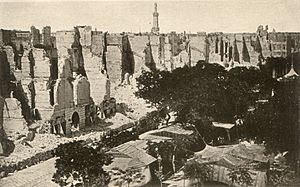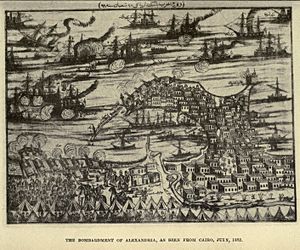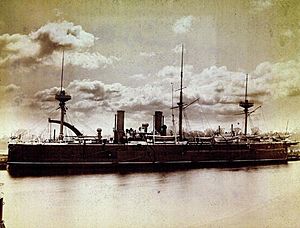Bombardment of Alexandria facts for kids
Quick facts for kids Bombardment of Alexandria |
|||||||
|---|---|---|---|---|---|---|---|
| Part of the Anglo-Egyptian War | |||||||
 Alexandria in ruins after the bombardment |
|||||||
|
|||||||
| Belligerents | |||||||
| Commanders and leaders | |||||||
| Strength | |||||||
| British: 9 battleships 1 torpedo boat 1 steamer 5 gunboats |
11 forts | ||||||
| Casualties and losses | |||||||
| 6 killed 27 wounded |
100-150 killed, 250-350 wounded (Egyptian Army official figures) 600–700 killed (British and American estimates) |
||||||
| Unknown number of civilians killed Large sections of Alexandria destroyed in bombardment and subsequent fires |
|||||||
The Bombardment of Alexandria was a major event in Egypt in 1882. It happened when the British Mediterranean Fleet attacked the city of Alexandria. This attack took place from 11 to 13 July 1882.
Admiral Beauchamp Seymour led a fleet of fifteen Royal Navy ships. These ships had sailed to Alexandria's harbor to support the Egyptian ruler, khedive Tewfik Pasha. At the time, a nationalist uprising led by Ahmed 'Urabi was happening. 'Urabi's movement was against the Khedive's rule and his close ties to British and French money lenders. A French fleet also joined the British ships to show force. This helped the Khedive, who moved his court to the protected port. However, it also made 'Urabi's supporters stronger across Egypt.
On 11 June, unrest began in Alexandria. Many European residents left the city. 'Urabi's army started making the harbor's defenses stronger. The British told them to stop, but they refused. So, the British fleet began a 10-and-a-half-hour attack on the city. The French fleet did not join in. Some historians believe Admiral Seymour might have made the threat from the Egyptian forts seem bigger. He might have done this to convince the British government to act. After the attack, the British started a full invasion to bring back the Khedive's power. Egypt remained under British influence until 1952. The last British troops left in 1956.
Contents
Why Did the Bombardment Happen?
The Suez Canal's Importance
In 1869, the Suez Canal was opened by Khedive Isma'il of Egypt. This canal was a joint project between the Egyptian government and a French company. Many Egyptian workers died while building it. People often said that Egyptian blood ran in the canal before the water. The canal greatly shortened the sailing time from Britain to India. This made Britain very interested in Egypt.
Egypt's Debts and Foreign Control
The Egyptian government spent a lot of money under Khedive Isma'il. Because of this, Britain bought the Khedive's shares in the Suez Canal company in 1875. This made Britain a major partner, owning 40% of the company. Both France and Britain were worried about Egypt's growing debts. This led to them sharing control over Egypt. Egypt was still officially part of the Ottoman Empire, but Britain and France had a lot of power.
Rise of Egyptian Nationalism
This foreign control made Egyptian people feel more nationalistic. In 1881, Egyptian soldiers revolted. By February 1882, 'Urabi Pasha had taken almost complete control of the government. His rebellion showed how much Egyptians disliked foreign influence. 'Urabi gathered a militia and marched towards Alexandria. Meanwhile, European countries met in Constantinople to discuss restoring the Khedive's power. A combined British and French fleet was sent to Alexandria.
Fortifications and Ultimatum
The Egyptians began to strengthen their forts and defenses. The British government then sent more ships to Malta under Admiral Seymour. On 20 May 1882, the British and French fleets arrived in Alexandria. By 5 June, more warships had entered the harbor. Historians still debate why Britain sent these warships. Some say it was to protect the Suez Canal and prevent chaos. Others argue it was to protect British investors' money in Egypt.
The foreign fleet's presence made tensions worse in Alexandria. On 11 and 12 June, serious unrest broke out. Over 50 Europeans and 125 Egyptians were killed. British Admiral Seymour, who was on shore, barely escaped the crowds. 'Urabi ordered his forces to restore order. Many non-Egyptians left Alexandria. By 6 July, almost everyone who wasn't Egyptian had left.
The Egyptian army kept building up their forts. Admiral Seymour then gave an ultimatum to 'Urabi's forces. He said they must stop building defenses, or the British fleet would attack the city. The French admiral told Seymour that the French fleet would leave if the British attacked. The ultimatum was ignored and expired at 7:00 am on 11 July.
The Battle of Alexandria
At dawn on 11 July, the British gun-ship Helicon entered the harbor. It flew flags to show it carried a message from the Egyptian government. At 7:00 a.m., Admiral Seymour gave the order to attack. His ship, HMS Invincible, signaled to HMS Alexandra to start firing.
Opening Shots and Fort Attacks
A steady exchange of cannon fire began between the British ships and Egyptian forts. The British ships moved around to keep firing. By 9:40, HMS Sultan, HMS Superb, and HMS Alexandra anchored near the Lighthouse Fort. They focused their guns on Ras El Tin. The fort's guns hit Alexandra several times. But by 12:30, HMS Inflexible joined the attack, and the fort's guns stopped firing.
Meanwhile, HMS Temeraire attacked the Mex Forts. HMS Invincible also fired at both Ras El Tin and Mex. Temeraire caused damage to Mex but then got stuck on a reef. The gunboat HMS Condor helped Temeraire get free. Temeraire then continued its attack on Mex Fort.
Close-Range Engagements
While some ships fired from far away, HMS Monarch, HMS Penelope, and HMS Condor were ordered to get closer to the forts at Maza El Kanat and Fort Marabout. HMS Condor saw that Invincible was within range of Fort Marabout's guns. So, Condor sailed very close, about 1,200 feet from the fort, and began firing heavily. When Fort Marabout's guns were disabled, the main British ship signaled "Well Done, Condor." Condor's brave action allowed the other ships to finish off Fort Mex.
Silencing the Forts
With Mex Fort's guns silenced, HMS Sultan signaled Invincible to attack Fort Adda. Invincible did this with help from Temeraire. At 1:30 p.m., a lucky shell from HMS Superb hit Fort Adda's ammunition storage. The fort's guns stopped firing. Around this time, the British fleet started running low on ammunition. However, almost all the Egyptian guns from Fort Adda westward were silenced. HMS Superb, Inflexible, and Temeraire focused their fire on the remaining eastern forts. At 5:15 p.m., the order was given to stop firing. The Egyptians, though outnumbered and outgunned, had fought well. Still, the outcome of the battle was clear. A newspaper in Cairo wrongly reported that the Egyptian forts had sunk three British ships.
After the First Day
The next day, HMS Temeraire checked the forts. It found that the Hospital battery had rebuilt its defenses. At 10:30 a.m., Temeraire and Inflexible began firing again. The battery raised a white flag at 10:48 a.m., signaling a truce. Soon, an Egyptian boat with a white flag went to the British flagship. A cease-fire was ordered. But by 2:50 p.m., HMS Bittern signaled that talks had failed. The bombardment was to start again. Still, most forts flew white flags, and the British fleet fired only irregularly.
By 4:00 p.m., a fire had started on shore. By evening, the fire had spread to the richest part of Alexandria, where many Europeans lived. The fire burned for two more days before it stopped. Admiral Seymour was unsure about the situation in the city. He did not send any troops ashore to take control or fight the fire. British marines and sailors finally landed in Alexandria on 14 July.
What Happened Next?
Many shells fired by the Royal Navy missed their targets. They landed in the city, causing deaths and injuries to people. They also damaged or destroyed many buildings and started fires. This damage was made worse by panic and looting. Many buildings made unsafe by the bombardment were later torn down by the British.
British sailors and marines landed in the ruined city. They tried to take control and stop the looting. They also tried to support the Khedive's weak government. Eventually, order was restored. A month later, General Garnet Wolseley brought a large force of British troops to Alexandria. This was a starting point for attacking 'Urabi near the Suez Canal at the Battle of Tell El Kebir.
Photographer Luigi Fiorillo created an album of fifty pictures. These photos showed how Alexandria changed during and after the attack. You can find these photos online at The American University of Cairo's digital library.
The bombardment was criticized by some, like British politician Henry Richard. He compared it to someone breaking into your house because you put up locks to protect yourself. After the 'Urabi revolt was stopped, Egypt came under British military control. It remained under British influence, even as a British Protectorate from 1914-1922, until after the Second World War.
British Fleet Ships

Battleships
- HMS Alexandra
- HMS Superb
- HMS Sultan
- HMS Temeraire
- HMS Inflexible
- HMS Monarch
- HMS Invincible
- HMS Penelope
Torpedo boat
- HMS Hecla
Despatch boat
- HMS Helicon
Gunvessels
- HMS Bittern
- HMS Beacon
- HMS Condor
- HMS Cygnet
- HMS Decoy
Egyptian Forts Attacked
- Citadel of El Max
- Citadel of Qaitbay
- Fort Adda
- Fort Agami
- Fort Kamaria
- Fort Marabout
- Fort Omuk Kebebe
- Fort Ras El Tin
- Fort Saleh Aga
- Fort Silsileh
- Marza El Kana
Images for kids
See also
- List of conflicts in the Near East








